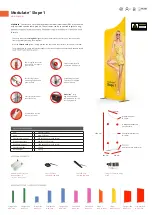
OM-7986
Page 6 of 23
Issue A - Rev 8
With a waterproof and scratch-proof label or pen mark the acoustic identity clearly on the
housing of the LRT. Make a permanent note of the transponder identity (& serial number if
required) on file with the associated GPS drop position.
WARNING
– Once deployed there is no way to automatically read a transponder’s
programmed identity. All identities must be cycled through whilst checking for a response to
determine the programmed identity.
2.3
Measuring the Battery Voltage
The internal battery voltage of the transponder can be read by connecting the loop around
the transducer and pressing the BATTERY button. The transponder reads its own battery
voltage and sends an acoustic telemetry message to the surface unit.
The voltage is accurate to 0.25 volts.
BATTERY TYPE vs
Voltage/Life/Source Level
Alkaline
10 cell
(641-2414)
Lithium
2 x 4 cells
(640-8515)
Lithium
TX & RX
(640-8864)
Initial Voltage (volts)
16.0
14.1
14.1
Start Voltage (volts)
15.0
14
14
End of Life (volts)
11.25
N/A
N/A
Capacity (mAh)
~2500
~4200
~6300
Typical Listening Life(months)
See note below
18 34 51
)
See note below
187-188 186-187 186-188
Typical Listening Life = the maximum battery life due whilst listening only.
(this assumes the transponder is only rarely interrogated or released)
2.4
Loading The Release Mechanism
NOTE
– Grease the stainless steel shaft of the release mechanism and the release ‘nut’
thread with underwater grease prior to loading the mechanism. Although the glass re-
enforced plastic is already impregnated with lubricant, this significantly reduces the friction.
This in turn reduces the starting torque on the motor, and therefore significantly increases the
release load reliability of the LRT.
You can only load the release mechanism using the loop. You cannot load the release
mechanism using the remote transducer.
Connect the loop around the transducer. Turn the right hand most dial (FREQUENCY) to the
LOAD position. Press the green button marked BATTERY/LOAD.
The surface unit will send a telemetry command to the transponder to rotate the shaft for 60
seconds. During this period insert the ‘nut’ onto the shaft ensuring it engages cleanly.
Loading the nut will take approximately 30 seconds before it bottoms against the endcap.
Whilst loading the release mechanism is set to low-power and the current drawn by the motor
is automatically sensed to detect when the nut bottoms against the endcap.
When high current is sensed, indicating the nut has been fully loaded, the release
mechanism will reverse direction for 1.5 seconds and wind the nut off the endcap. This is to
minimise the power required on start-up to release the nut in operation.








































